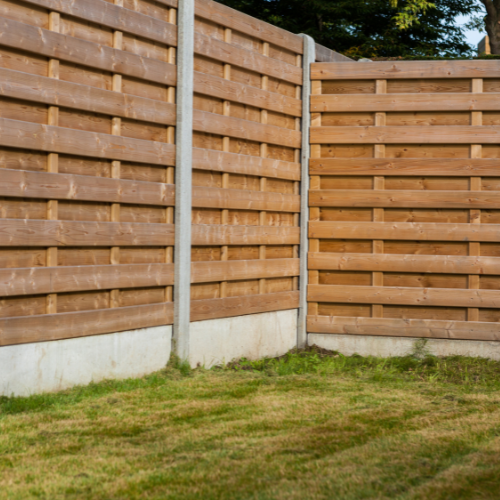Denver, CO, is known for its varying climate, from sunny days to heavy snowfall. Homeowners in the area must take extra steps to maintain their outdoor structures, including fences, which are exposed to harsh weather conditions. Fence staining is an essential practice for preserving the durability and beauty of wooden fences. By selecting the right stain, applying it correctly, and maintaining it over time, you can extend the lifespan of your fence while enhancing the aesthetics of your outdoor space.
Choosing the Right Stain for Your Fence
Understanding the Different Types of Stains
Wood stains come in various types, including transparent, semi-transparent, and solid stains. Transparent stains offer minimal color alteration but protect against moisture. Semi-transparent stains allow some of the wood grain to show through while providing increased protection. Solid stains, on the other hand, offer the most coverage and durability, making them an excellent choice for fences that experience high exposure to the elements.
Oil-Based vs. Water-Based Stains
Oil-based stains penetrate deep into the wood, providing long-lasting protection and rich color enhancement. They are ideal for homeowners seeking a durable solution with less frequent reapplication. Water-based stains, however, dry faster and are more environmentally friendly. They offer a wide range of color options and are easier to clean up, making them a popular choice for DIY projects.
Considering the Local Climate
Since Denver experiences fluctuating temperatures and varying moisture levels, choosing a stain that offers UV and water resistance is crucial. High-quality fence staining products will ensure the wood remains protected year-round. Regular maintenance, combined with the right stain selection, can prevent cracking, warping, and fading.
Preparing Your Fence for Staining
Cleaning and Repairing the Fence
Before applying stain, thoroughly clean your fence to remove dirt, mildew, and old stain residue. Use a pressure washer to remove stubborn grime or a soft washing technique if the wood is delicate. Any cracks or holes should be filled with wood filler to create a smooth surface.
Sanding for a Smooth Finish
Sanding the wood ensures even stain absorption. Use fine-grit sandpaper to remove rough spots and create a uniform surface. This step is especially important if the fence has been previously painted or stained and needs refinishing.
Applying a Primer for Best Results
While not always necessary, using a primer can enhance stain adhesion, especially if switching between stain types. A professional exterior painting service can help determine whether priming is necessary for your fence type.
Application Techniques for Maximum Protection
Using the Right Tools
A brush, roller, or sprayer can be used to apply stain, depending on the size and complexity of your fence. Brushes offer the most control, ensuring the stain penetrates deep into the wood grain. Sprayers allow for faster application but may require back-brushing to eliminate streaks.
Applying Thin, Even Coats
Thick stain application can lead to uneven drying and a blotchy appearance. Multiple thin coats ensure even coverage and proper absorption. Allow each coat to dry before adding another layer to avoid tackiness.
Paying Attention to Drying Time
Drying time varies based on stain type and weather conditions. Oil-based stains take longer to dry but provide superior durability. Water-based stains dry faster and may require multiple coats for full coverage. Choosing the right staining technique will impact the final result.
Fence Maintenance Tips for Longevity
Regular Cleaning and Inspection
Routine maintenance helps prolong the life of your fence stain. Wash your fence periodically to remove dirt and debris. Inspect for signs of wear, such as peeling or fading, and reapply stain as needed.
Re-Staining at the Right Time
Depending on the stain type and weather exposure, fences may require re-staining every two to five years. Solid stains last longer than transparent stains, but they may require touch-ups sooner in high-exposure areas.
Protecting Your Fence from Moisture and UV Rays
Applying a UV-resistant top coat can help shield your fence from excessive sun exposure. Additionally, ensuring proper drainage around your fence will prevent wood rot caused by prolonged moisture exposure.
Answering Common Questions
How often should I stain my fence? The frequency of fence staining depends on the type of stain used, weather conditions, and overall maintenance. Most fences require re-staining every two to five years.
What is the best time of year to stain a fence? Spring and fall offer the best weather conditions for staining, as moderate temperatures and low humidity allow for optimal drying and absorption.
Can I stain a fence myself, or should I hire a professional? While DIY staining is possible, hiring a professional painting service ensures even application, proper preparation, and long-lasting results.
The Impact of Fence Staining on Property Value
A well-maintained fence enhances curb appeal and adds to the overall value of your property. A professionally stained fence can also improve the aesthetic harmony of your outdoor space.
Choosing a Reliable Painting Contractor in Denver, CO
For homeowners seeking expert fence staining, Dream Painting LLC offers high-quality exterior painting and staining services tailored to local conditions. Our experienced team ensures professional results with lasting durability.
Schedule Your Fence Staining Service Today
If you’re looking to protect and enhance your fence, reach out to Dream Painting LLC for expert fence staining solutions. Our dedicated team is here to help you achieve long-lasting beauty and durability for your outdoor spaces.

